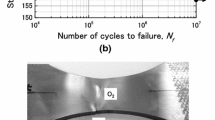Abstract
The application of acoustoelasticity using critically refracted longitudinal (LCR) waves is described for measuring residual stress in welded steel plates. Residual stresses are self-equilibrating and may exist in a material that has been deformed in a nonhomogeneous manner. When unknown residual stress is present in a structure, the true stress may become significantly greater than the working stress. In a corrosive environment, highly stressed areas that have not been properly stress relieved are prone to stress corrosion cracking. Areas near welds are particularly susceptible to stress corrosion cracking.
Two welded plates were investigated for the present work: one hot-rolled and the other cold-rolled. Residual stresses are usually greatest after welding. Further, longitudinal stress (i.e., stress parallel to the weld bead) is typically greater than the component transverse to the weld bead. Since the acoustoelastic behavior of the LCR wave is largest when propagated parallel to a uniaxial stress, the LCR wave traveling parallel to the weld bead was used to investigate the stress changes after stress relieving of the welded plates. Both 1 MHz and 2.25 MHz probe frequencies were used in this study. The stress changes in the welds and in the cold-rolled plate were clearly indicated by the LCR data.
Two verification methods were used: hole drilling (HD) and neutron diffraction (ND). The stress relief was verified by the hole-drilling technique. While the HD technique showed about the same stress magnitude as found by the LCR results, the orientation was reversed. The stress orientation was probably caused by the grinding process used to flatten the weld bead. Texture was also investigated using a neutron diffraction (ND) technique on the (001)[110] texture. The through-the-thickness technique yields an average of the orientation distribution of the (110) planes. At locations in the parent metal and in the weld, the distribution was found to be very similar, indicating uniform texture throughout the weld and parent metal zones.
Similar content being viewed by others
References
K. Heindlhofer.Evaluation of Residual Stress, First Edition, McGraw-Hill, New York (1948)
G.E. Dieter, Jr.Mechanical Metallurgy, Third Edition, McGraw-Hill, New York (1986)
W.M. Baldwin, Jr.Residual Stress, Metal Progress 68 (24) 89–96 (1955)
K. Masubuchi.Residual Stresses and Distortion, Welding, Brazing and Soldering, VI, Metals Handbook, American Society for Metals, Ninth Edition, Metals Park, OH, pp. 856–895, (1983)
B.D. Cullity.Elements of X-ray Diffraction, Second Edition, Addison-Wesley Publishing Co. Inc., Reading, Massachusetts (1978)
A.J.A. Parlane.The Determination of Residual Stresses: A Review of Contemporary Measurement Techniques, Proceedings of the International Conference in Residual Stresses in Welded Construction and Their Effects,” London, U.K., pp. 63–78 (November, 1977)
R.M. James and O. Buck.Quantitative Nondestructive Measurement of Residual Stresses, Critical Review in Solid State and Material Sciences 9 (1) 61–105 (1980)
E. Macherauch et al.Different Sources of Residual Stress as a Result of Welding, Proceedings of the International Conference in Residual Stresses in Welded Construction and Their Effects, London, U.K., pp. 267–282 (November, 1977)
K. Masubuchi.Analysis of Welded Structures, First Edition, Pergamon Press, Oxford (1980)
C.S. Barrett and T.B. Massalski.Structure of Metals, Third Edition, McGraw-Hill, New York (1966)
D.E. Bray, and R.K. Stanley.Nondestructive Evaluation, McGraw-Hill, New York, pp. 152–157 (1989)
T.D. Murnaghan.Finite Deformation of an Elastic Solid, First Edition, John Wiley & Sons, New York (1951)
D.S. Hughes and J.L. Kelly.Physical Review 92 (5) 1145–1149 (1953)
D.M. Egle and D.E. Bray.J. Acoust. Soc. Amer. 60 (3) 741–744 (1976)
P. Junghans and D. E. Bray. Beam Characteristics of High Angle Longitudinal Wave Probes,NDE: Applications, Advanced Methods, and Codes and Standards, PVP-Vol-216, ed. by R.N. Pangborn et al. NDE Vol. 9, Proceedings 1991 ASME Pressure Vessels and Piping Conference, San Diego, California, June 23–27, 1991, pp. 39–44
K.J. Langenberg, P. Fellenger, and R. Marklein.Res. Nondest. Eval. 2 59–81 (1990)
L.M. Brekhovskii.Waves in Layered Media, First Edition, Academic Press, New York (1960)
L.V. Basatskaya and I.N. Ermolov.The Soviet Journal of Nondestructive Testing (Defektoskopiya) 6 (7) 524–530 (1980)
American Society for Testing and Materials,Preparing Quantitative Pole Figures of Metals, ASTM Standard E-81-63, Part II, Philadelphia, PA, pp. 137–154 (1975) American Society for Testing and Materials, E-837-92
Measurements Group,Measurement of Residual Stresses by the Hole-Drilling Strain-Gage Method, Measurements Group Tech Note, TN-503-3, Raleigh, North Carolina (1988)
H. Takechi et al.Transactions of the American Institute of Mining, Metallurgical and Petroleum Engineers 242 (1) 56–65 (1968)
D.R. Allen and C.M. Sayers.NDT International 4 (5) 263–269 (1981)
T. Leon-Salamanca.Ultrasonic Measurement of Residual Stress in Steels using Critically Refracted Longitudinal Waves (L CR ), Texas A&M University, Department of Mechanical Engineering, Ph D. Dissertation (1988)
T. Leon-Salamanca and D.E. Bray.Ultrasonic Measurement of Residual Stress in Steels Using Critically Refracted Longitudinal Waves (L CR ), Proceedings 1990 Spring Conference on Experimental Mechanics, Society for Experimental Mechanics, June 3–6, 1990. Albuquerque, NM, pp. 271–278
D.E. Bray, T. Leon-Salamanca, and P. Junghans.Applications of the L CR Ultrasonic Technique for Evaluating Post Weld Heat Treatment in Steel Plate, Nondestructive Evaluation NDE Planning and Application, NDE-5, ed. by R. Streit, Proceedings 1989 Pressure Vessels and Piping Conference, Honolulu, Hawaii, July 23–27, 1989, pp. 191–197
Author information
Authors and Affiliations
About this article
Cite this article
Leon-Salamanca, T., Bray, D.F. Residual stress measurement in steel plates and welds using critically refracted longitudinal (LCR) waves. Res Nondestr Eval 7, 169–184 (1996). https://doi.org/10.1007/BF01606385
Issue Date:
DOI: https://doi.org/10.1007/BF01606385



